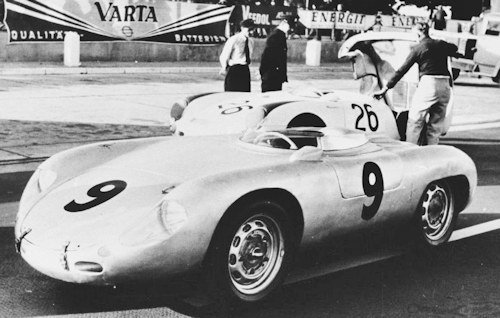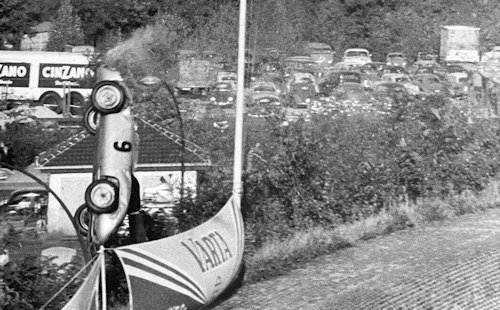Porsche 645
 | |
Presentation Year: | 1956 |
Class : | sports car |
Body design : | Roadster |
Engine: | Gasoline :1.5 liters (85 kW) |
Length: | 3775 mm |
Width: | 1420 mm |
Height: | 900 mm |
Wheelbase: | 2000 mm |
Empty weight: | 550 kg |
The Porsche 645 Spyder was a racing sports car prototype fom 1956 of Dr.-Ing. hc F. Porsche KG . This was planned as a successor to the Porsche 550 . However, the development of the car was stopped before completion in favor of the Porsche 718 .
History
The Porsche Type 645 was first developed in late 1954. The idea was to create a race car that was lighter than the Porsche 550. This should also provide improved aerodynamics and more friction.
Egon Forstner, the chief of Porsche's calculating department, initiated the idea. This was backed up by Ernst Fuhrmann, the designer of the Type 547 engine, and Heinrich Klie, the automobile and body designer. Klie created a 1:5 scale model based on the 550 to experiment with numerous new body characteristics. These included an aerodynamically integrated body headrest and a rear-opening gap through which turbulence-swirled air for engine cooling could flow more freely in the engine compartment.
Klie and Fuhrmann were granted patents for the two new developments.
On February 15, 1955, in the midst of the development of the 645, the Porsche chief engineer Karl Rabe asked the management to review the project, as it needed more staffing and more funds. Then the project was stopped, especially since the 550 racing cars used proved to be competitive and no new car was needed. Only when Porsche expected a competition with the announced newly revised Borgward RS , the project was resumed on 16 February 1956. In the issued work instruction no. 9159, the construction of two prototypes was commissioned.
The first prototype was completed in mid-June 1956 for testing. Herbert Linge tested the vehicle at Malmsheim . It turned out that the car was faster, but in his driving behavior hardly predictable and difficult to control than the 550.
Porsche put the 645, driven by Richard von Frankenberg , in some races. On 16 September 1956 accident of Frankenberg with the car at the race on the AVUS . Frankenberg was thrown out of the car; he survived the accident slightly injured. The only finished prototype burned out completely. After that, the project was discontinued. Many insights gained during development were included in the later produced Porsche 718 and successfully implemented there.
Bodywork and Suspension
The Porsche 645, which was developed in 1954, already had a tubular frame , as it was later used on the Porsche 550 A in 1956. In order to achieve the lowest possible vehicle weight, the body shell was made of the lighter magnesium instead of aluminum . At the same time the car was compared to the 550 smaller, so that the wheelbase was shortened by 100 mm to 2000 mm.
In order to reduce the top speed and thus the drag of the racing car in order to increase the maximum speed, the developers reduced the track width at the front to 1190 mm and at the rear to 1150 mm. Because of its small size and especially because of his erratic driving behavior called Richard von Frankenberg the car later Mickey Mouse.
The front was pulled down deeper and already resembled that of the later Porsche 718 .The tail was redesigned and had two left and right rear facing openings for the engine air intake and an open also to the rear gap for engine cooling. To accommodate the fan for the engine cooling, the rear had a bulge in the middle.The capacity of the fuel tank placed in the front was reduced from 130 to 80 liters to fit in the small body. To compensate, Porsche installed a 40 to 50-liter tank to the right of the driver in the driver's cab.
The car had front and rear independent suspension, front as crank arm axle . The rear suspension was unlike the 550 run and was similar to the former Porsche race car project Cisitalia 360 She had the torsion springs associated trailing arm and upper and lower control arms. The control arms were swept slightly backwards. The lower handlebars ran parallel to the ground, while the upper handlebar pointed slightly downwards. Like the 550, the prototype had drum brakes all around . On the 16-inch wheels, tires in the size 5.00-16-RS and 5.25-16-RS were mounted in the front.
Engine and transmission
The vehicle was powered by an early version of the so-called Fuhrmann engine type 547, since the newer variant needed more space, which was not available in the small engine compartment of the 645th This air-cooled 1.5-liter four-cylinder boxer engine produced about 15 kW (20 hp) less than the more modern version of the type 547, which delivered 99 kW (135 hp) at 7200 rpm, and also had two on each side Camshafts driven by vertical shafts.The engine had a double ignition with two separate ignition distributors and two ignition coils. For the mixture preparation two Weber double precipitator type 40 DCM were used. The maximum torque was 145 Nm at 5900 rpm.The fully synchronized four-speed manual transmission was taken from the Porsche 550 and was also placed behind the rear axle.
Race History
The first test runs on a racetrack contested the prototype on 15 and 16 May 1956 at the Nürburgring . Dangers became the car of Wolfgang von Trips , who thus achieved a lap time of less than eleven minutes. Parallel drove Hans Herrmann a 550 A and undercut with 10: 35.2 minutes the time of the 645th After Herrmann had tested the 645, he came to the conclusion that the car, although faster, but "absolutely impassable".On May 27 of the same year Richard von Frankenberg tested the prototype during training for the 1000 km race at the Nürburgring . During the actual race, he waived and Hans Hermann on its commitment to, the Porsche 550 A, achieved sixth place in the standings with both.
The first race use of 645 on July 22, 1956 at the Solitude race. From Frankenberg, starting from second place had to fight during the race with technical problems. Despite the loss of the first gear, brake problems, power loss and high oil temperatures, he finished the race in fourth.
The second and final race of the prototype took place on 16 September 1956 at the Grand Prix of Berlin, the sixth race of the German Sports Car Championship, at the AVUS. From Frankenberg, won the race with the so-called Mickey Mouse to drive because the car reached a higher top speed than the 550 and the race track with its long straights and few corners was designed for high speeds. With starting number 9 starting from third place, von Frankenberg took the lead, followed by Wolfgang von Trips with a 550 A. The car crashed into the paddock, which was about 15 meters down, where it immediately caught fire and completely burned out, including the magnesium body. About five minutes after the accident found a Porsche engineers the unconscious Richard von Frankenberg, who was thrown when departing on the steep curve of the car.After this event, no further 645 was built and the project ended.

Rating
Technical
-
Porsche 645 Technical data
Porsche 645 Spyder:
dates
Engine:
4-cylinder boxer engine (four-stroke) (type 547)
displacement:
1498 cc
Bore × stroke:
85 × 66 mm
power
85 kW (115 hp) at 7200 rpm
Max. Torque :
145 Nm at 5900 rpm
Compression:
9.8: 1
Valve control:
twice two overhead camshafts, driven by king shafts
Cooling:
Air cooling (vertical fan)
Transmission:
4-speed transmission
brakes:
drum brakes
Front suspension:
Crank trailing arm
Rear suspension:
asymmetric wishbones
Front suspension:
Torsion bars
Rear suspension:
1 round torsion bar on each side
Body:
Spaceframe
Track front / rear:
1190/1150 mm
Wheelbase :
2000 mm
Tires:
5.00-16 RS / 5.25-16 RS; 5.50-16
Dimensions L × W × H:
3775 × 1420 × 900 mm
Curb weight :
550 kg
maximum speed:
260 km / h




